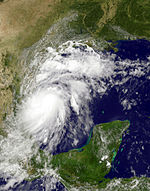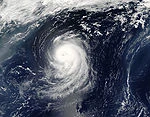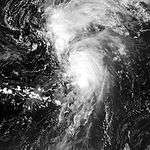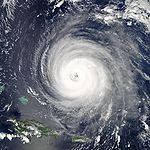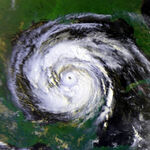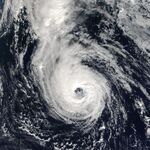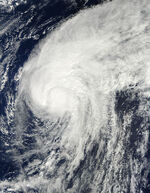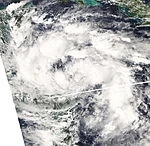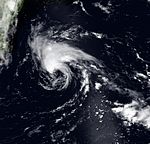The 2013 Atlantic hurricane season was an extremely active season, with 23 depressions forming. 21 of these depressions became named storms, 14 became hurricanes, and 5 became majors. This was the 2nd most active season in history, beating 1933 by only 1 storm.
This season was very destructive and deadly. The storms Fernand, Ingrid, and Pablo caused most of the destruction. Fernand and Ingrid reached Category 5 intensity, making 2013 the first season since 2007 to have Category 5 storms. It was also the first season since that year in which there were 2 Category 5 storms, and the 5th season on record with more than one Category 5 storm. Fernand struck the Carolinas at C3 intensity, Ingrid struck Texas at C4/C5 intensity, and Pablo caused devastation and deaths in Mexico. Also, Wendy was a very post-season subtropical storm that formed on December 28 and dissipated on December 30. It was the latest storm since Zeta in 2005.
Season summary[]
The first storm, Andrea, formed on June 8 and struck Texas at C1 intensity. It was one of the earliest hurricane landfalls in the US on record. After that, Barry formed on June 21 but didn't affect land. In July, 2 storms, Chantal and Dorian, formed. After that, in August, 5 storms formed. They were Erin, TD 6, Fernand, Gabrielle, and Humberto. The most destructive storm of August, Fernand, was a C5 that passed close to the Lesser Antilles as a C4 and struck the Carolinas at C3 strength. There were 6 storms in September; Ingrid, Jerry, Karen, Lorenzo, Melissa, and Nestor. Ingrid was the most destructive of the season, reaching C5 strength and striking the Windward Islands as a C1, passing south of Jamaica as a C4/C5, striking the Yucatan as a C4, and striking Texas as a C4/C5. In October, 4 storms, Olga, Pablo, TD 18, and Rebekah formed. Olga was a long-lasting storm, peaking as a C1 and staying out in open waters. Although it lasted long, it didn't affect anyone. Pablo was a destructive and deadly C4 storm that struck Nicaragua as a C1, the Yucatan as a C4, and Veracruz as a C3. It was one of Mexico's most destructive storms. In November, 3 storms formed. They were Sebastien, Tanya, and Van. Also, Rebekah existed in the month after crossing from October, which means 4 storms existing in the month. It was the most active November on record alongside 2005. Finally, Wendy was a post-season subtropical storm that caused slight effects in the Lesser Antilles and Bermuda. It was the latest storm since Zeta in 2005, and the latest storm ever recorded that did not cross into the next year. Over all, there were 23 storms (including depressions), making this season the 2nd most active on record.
Timeline[]

List of storms[]
Hurricane Andrea[]
| Category 1 hurricane (SSHWS) | |
| Duration | June 8 – June 11 |
|---|---|
| Peak intensity | 80 mph (130 km/h) (1-min) 980 mbar (hPa) |
An area of disturbed weather in the Gulf of Mexico became a depression on June 8. It later strengthened into TS Andrea, and continued to strengthen as it approached Texas. Andrea strengthened into a Category 1 hurricane on June 10, and made landfall in eastern Texas later that day. It was probably one of the earliest US hurricane landfalls on record. Andrea quickly weakened over land and dissipated on June 11. Andrea caused $695 million dollars in damage and killed 21 people.
Tropical Storm Barry[]
| Tropical storm (SSHWS) | |
| Duration | June 21 – June 25 |
|---|---|
| Peak intensity | 70 mph (110 km/h) (1-min) 989 mbar (hPa) |
A depression formed on June 21 northeast of Florida from a cold front. It later became TS Barry and strengthened to its peak of 70 mph north of Bermuda. Cooler waters started to weaken it, and it became extratropical on June 25. Barry didn't affect land.
Hurricane Chantal[]
| Category 1 hurricane (SSHWS) | |
| Duration | July 13 – July 16 |
|---|---|
| Peak intensity | 80 mph (130 km/h) (1-min) 979 mbar (hPa) |
An area of disturbed weather became a depression on July 13 in the southwestern Gulf of Mexico. It later became TS Chantal. Chantal moved west-northwest as it gradually strengthened. It became a hurricane and reached its peak of 80 mph before making landfall in northeast Mexico on July 15. It dissipated early the next day over the mountains of Mexico. Chantal caused $18 million dollars in damage and killed 3 people.
Hurricane Dorian[]
| Category 2 hurricane (SSHWS) | |
| Duration | July 26 – August 2 |
|---|---|
| Peak intensity | 105 mph (165 km/h) (1-min) 967 mbar (hPa) |
A tropical wave became organized enough to be declared a depression on July 26. It strengthened into TS Dorian, and continued to slowly strengthen as it passed northeast of the Lesser Antilles. Dorian soon became a hurricane, and continued to strengthen. It reached C2 status southeast of Bermuda, and reached its peak of 105 mph on July 30. Cooler waters and increasing wind shear started to weaken the storm, and it became extratropical on August 2. Dorian didn't affect land except for some rain in the Lesser Antilles, Bermuda, and Newfoundland.
Tropical Storm Erin[]
| Tropical storm (SSHWS) | |
| Duration | August 4 – August 7 |
|---|---|
| Peak intensity | 50 mph (85 km/h) (1-min) 995 mbar (hPa) |
A tropical depression formed on August 4 in the Gulf of Mexico from an area of disturbed weather. It later became a tropical storm and was named Erin. Erin moved northeastward as it slowly strengthened. It reached its peak intensity of 50 mph before making landfall in the Florida Panhandle on August 6. Erin weakened over land before dissipating early on August 8. Erin caused $25 million dollars in damage and 4 deaths, mainly caused by a line of severe thunderstorms and tornadoes from Erin on its south and east sides.
Tropical Depression Six[]
| Tropical depression (SSHWS) | |
| Duration | August 12 – August 13 |
|---|---|
| Peak intensity | 35 mph (55 km/h) (1-min) 1004 mbar (hPa) |
A tropical wave became a depression on August 12 east of the Lesser Antilles. It moved westward without strengthening and dissipated the next day. Its remnants impacted the Lesser Antilles just after it dissipated. TD Six caused minimal damage.
Hurricane Fernand[]
| Category 5 hurricane (SSHWS) | |
| Duration | August 16 – August 25 |
|---|---|
| Peak intensity | 165 mph (270 km/h) (1-min) 912 mbar (hPa) |
Fernand formed on August 16 west of the Cape Verdes from a tropical wave. It moved westward as it gradually strengthened. Fernand became a hurricane early on August 19 and started to strengthen quicker. Under warm waters and low wind shear it became a major hurricane on August 20 and a C4 hurricane early on August 21. It passed north of the Lesser Antilles at that intensity. Fernand continued to strengthen under the favorable conditions, and it became a C5 hurricane on August 22. Fernand was the first Category 5 hurricane since Felix in 2007. It reached its peak intensity of 165 mph before wind shear started to weaken it. Fernand weakened to a C4 hurricane on August 23 as it approached the east coast of the US. It made landfall in the Carolinas on August 24 as a C3 hurricane, the first major hurricane landfall in the US since Wilma in 2005. Fernand rapidly weakened over land before dissipating on August 25. Fernand caused $14 billion dollars in damage and 67 deaths.
Tropical Storm Gabrielle[]
| Tropical storm (SSHWS) | |
| Duration | August 22 – August 25 |
|---|---|
| Peak intensity | 60 mph (95 km/h) (1-min) 992 mbar (hPa) |
A depression formed on August 22 east of Bermuda. It later strengthened into TS Gabrielle, and continued to strengthen as it moved northeastward. Gabrielle peaked at 60 mph and started to weaken after that due to cooler waters and higher wind shear. It became extratropical on August 25 southeast of Newfoundland. Gabrielle was never a threat to land.
Hurricane Humberto[]
| Category 3 hurricane (SSHWS) | |
| Duration | August 27 – September 2 |
|---|---|
| Peak intensity | 120 mph (195 km/h) (1-min) 956 mbar (hPa) |
Humberto formed on August 27 west of the Cape Verdes from a tropical wave that moved off the coast of Africa on August 25. It moved northwestward as it gradually strengthened. Humberto became a hurricane on August 29. It later became a C2 hurricane early on August 30 and a C3 hurricane later that day as it turned northward. Humberto reached its peak of 120 mph before weakening. It became extratropical on September 2 before impacting the western Azores as an extratropical storm. Humberto caused minimal damage.
Hurricane Ingrid[]
| Category 5 hurricane (SSHWS) | |
| Duration | September 5 – September 16 |
|---|---|
| Peak intensity | 175 mph (280 km/h) (1-min) 899 mbar (hPa) |
Ingrid formed in the Central Atlantic on September 5. It moved westward as it strengthened. It became a hurricane near the Windward Islands, and crossed the islands at C1 strength. Under warm sea surface temperatures of at least 85 degrees and low wind shear, it became a major hurricane early on September 9 in the Caribbean. Ingrid later became a C4, and then a C5 as it passed south of Jamaica. It caused lots of destruction on the island. Continuing westward, it weakened into a C4 as it approached the Yucatan because of an eyewall replacement cycle. Ingrid made landfall on the tip of the Yucatan on September 12 at C4 strength. It then entered the Gulf of Mexico after causing destruction in the Yucatan and restrengthened into a C5. Ingrid reached its peak of 175 mph before making landfall near Galveston, TX late on September 14 with 165 mph winds. It weakened over land before dissipating on September 16 while in Indiana. Ingrid caused $72 billion dollars in damage and killed 445 people, making it the 2nd most costliest hurricane in history, after Katrina in 2005.
Hurricane Jerry[]
| Category 1 hurricane (SSHWS) | |
| Duration | September 6 – September 9 |
|---|---|
| Peak intensity | 75 mph (120 km/h) (1-min) 984 mbar (hPa) |
Jerry formed on September 6 in the Central Atlantic. It moved north as it strengthened. Under favorable conditions, it became a hurricane on September 8. It remained at the minimum strength for hurricanes before cooler waters and increasing wind shear weakened the storm. Jerry became extratropical on September 9. Jerry didn't affect land, but its extratropical remnants caused some rain in Newfoundland.
Hurricane Karen[]
| Category 4 hurricane (SSHWS) | |
| Duration | September 12 – September 23 |
|---|---|
| Peak intensity | 150 mph (240 km/h) (1-min) 934 mbar (hPa) |
Karen formed on September 12 south of the Cape Verdes from a tropical wave. It gradually strengthened as it moved westward. It became a hurricane late on September 15 and started to strengthen faster. Karen reached C2 strength on September 16, C3 strength early on September 17, and C4 strength early on September 18. Karen reached its peak of 150 mph while passing north of the Lesser Antilles before an eyewall replacement cycle weakened the storm to a C3. It later restrengthened into a C4 before weakening again, this time due to cooler water temperatures and increasing wind shear. Karen made landfall in Newfoundland as a C1 before becoming extratropical on September 23. Karen caused $92 million dollars in damage and 4 deaths, mainly in Newfoundland.
Hurricane Lorenzo[]
| Category 1 hurricane (SSHWS) | |
| Duration | September 17 – September 22 |
|---|---|
| Peak intensity | 80 mph (130 km/h) (1-min) 981 mbar (hPa) |
Lorenzo formed in the western Caribbean on September 17. It strengthened as it moved toward Belize and the Yucatan. It reached hurricane strength under favorable conditions. Lorenzo reached its peak of 80 mph before making landfall slightly north of Belize on September 19 at that strength. It quickly weakened as it moved across the Yucatan and emerged into the Gulf of Mexico as a tropical depression. Lorenzo restrengthened into a TS and reached a second peak intensity of 60 mph in the southwest Gulf of Mexico. It made landfall near Veracruz with winds of 50 mph, and rapidly weakened over the mountains of Mexico. Lorenzo dissipated on September 22 only 12 hours after landfall. Lorenzo caused $150 million in damage and killed 9 people.
Tropical Storm Melissa[]
| Tropical storm (SSHWS) | |
| Duration | September 21 – September 23 |
|---|---|
| Peak intensity | 40 mph (65 km/h) (1-min) 1000 mbar (hPa) |
A depression formed late on September 21 west of the Cape Verdes. It moved slowly northwestward and became TS Melissa on September 22. Wind shear caused it to weaken back into a depression and dissipate on September 23. Melissa didn't affect anyone.
Hurricane Nestor[]
| Category 2 hurricane (SSHWS) | |
| Duration | September 28 – October 5 |
|---|---|
| Peak intensity | 105 mph (165 km/h) (1-min) 968 mbar (hPa) |
Formed in the western Caribbean on September 28. It moved northward as it strengthened. It became a hurricane before turning northeastward. The storm strengthened further into a C2 before impacting Cuba at that strength. It weakened into a C1 and passed through the Bahamas. Nestor further weakened into a TS as it was leaving the Bahamas. Continuing northeastward, it restrengthened into a C1 and passed near Bermuda at that strength. The storm weakened again after that and dissipated on October 5. Nestor caused $215 million in damage and killed 10.
Hurricane Olga[]
| Category 1 hurricane (SSHWS) | |
| Duration | October 10 – October 28 |
|---|---|
| Peak intensity | 90 mph (150 km/h) (1-min) 976 mbar (hPa) |
Formed as a subtropical storm on October 10 north of the Lesser Antilles. It became tropical a couple days later as it slowly moved northwestward and strengthened. Olga later became a hurricane before wind shear weakened the storm back to a TS. It then made a loop and turned toward the north. The storm restrengthened into a hurricane and reached its peak of 90 mph northwest of Bermuda. Olga started to weaken after that and weakened back into a TS north of Bermuda. It continued northeastward before becoming extratropical on October 28. Olga didn't affect land, but it did drown a surfer in North Carolina and brought some rain to Bermuda.
Hurricane Pablo[]
| Category 4 hurricane (SSHWS) | |
| Duration | October 16 – October 23 |
|---|---|
| Peak intensity | 140 mph (220 km/h) (1-min) 940 mbar (hPa) |
Pablo formed in the western Caribbean on October 16. It impacted Nicaragua as a C1 before quickly strengthening as it headed toward the Yucatan. Pablo made landfall in the Yucatan as a C4 before emerging into the Gulf of Mexico as a C1. The storm restrengthened into a C3 before impacting Veracruz as a C2. Pablo was only the second major hurricane to exist in the Bay of Campeche, after Karl in 2010. It dissipated over Mexico's mountains on October 23. Pablo caused $1.2 billion dollars in damage and killed 365 people throughout its path.
Tropical Depression Eighteen[]
| Tropical depression (SSHWS) | |
| Duration | October 25 – October 26 |
|---|---|
| Peak intensity | 35 mph (55 km/h) (1-min) 1006 mbar (hPa) |
Formed close to Nicaragua on October 25. It skirted the northern coast of the country before dissipating on October 26 without becoming a TS. This TD caused $43 million in damage and killed 62 people, mainly due to flash floods and mudslides.
Hurricane Rebekah[]
| Category 1 hurricane (SSHWS) | |
| Duration | October 28 – November 3 |
|---|---|
| Peak intensity | 85 mph (140 km/h) (1-min) 976 mbar (hPa) |
Rebekah formed on October 28 in the central Caribbean. It passed between Jamaica and Haiti as a TS before strengthening into a C1 and impacting Cuba at that strength. The storm weakened into a TS over Cuba, and remained a TS as it passed through the Bahamas. Rebekah later restrengthened into a C1 and reached its peak of 85 mph west of Bermuda. It started to weaken in cooler waters and increasing wind shear as it moved northeastward, and dissipated on November 3. Rebekah caused $125 million in damage and killed 12 people.
Tropical Storm Sebastien[]
| Tropical storm (SSHWS) | |
| Duration | November 8 – November 10 |
|---|---|
| Peak intensity | 60 mph (95 km/h) (1-min) 994 mbar (hPa) |
Sebastien formed southeast of Bermuda as a subtropical storm on November 8. It became fully tropical and reached its peak of 60 mph before weakening due to wind shear and cooling waters. The storm became extratropical on November 10. Sebastien didn't affect land.
Hurricane Tanya[]
| Category 1 hurricane (SSHWS) | |
| Duration | November 21 – November 24 |
|---|---|
| Peak intensity | 80 mph (130 km/h) (1-min) 982 mbar (hPa) |
Formed in the central Atlantic on November 21. Due to unusually favorable conditions for the time of year, it gradually strengthened as it moved northeastward. It continued to strengthen despite increasing wind shear and predictions for it to weaken, and then became a hurricane. The strengthening surprised NHC forecasters. Tanya reached its peak of 80 mph before finally weakening as it approached the western Azores. It became extratropical before impacting the western Azores on November 24. Tanya caused very minimal damage.
Tropical Storm Van[]
| Tropical storm (SSHWS) | |
| Duration | November 29 – November 30 |
|---|---|
| Peak intensity | 45 mph (75 km/h) (1-min) 998 mbar (hPa) |
Van formed in the central Caribbean on November 29. It gradually strengthened to its peak of 45 mph before impacting Nicaragua and dissipating the next day. Van caused minimal damage and 2 deaths. It was the 4th storm to exist in November, making it one of the most active Novembers on record.
Subtropical Storm Wendy[]
| Subtropical storm (SSHWS) | |
| Duration | December 28 – December 30 |
|---|---|
| Peak intensity | 50 mph (85 km/h) (1-min) 997 mbar (hPa) |
A subtropical depression formed north of the Lesser Antilles on December 28, just a few days before the end of the year and nearly a month after the end of the season. It moved north and gradually strengthened, becoming Subtropical Storm Wendy. Wendy reached its peak of 50 mph east of Bermuda before rapidly weakening. It dissipated on December 30 after never becoming tropical throughout its lifetime. Wendy caused minimal damage. It was also the latest storm since Zeta in 2005 and the latest storm ever recorded that did not cross into the next year, beating a hurricane in 1822, which formed on December 13.
Storm names[]
The following names were used to name tropical cyclones this year. This is the same list that was used in the 2007 season, except for Dorian, Fernand, and Nestor, which replaced Dean, Felix, and Noel. The names Dorian, Fernand, Nestor, Rebekah, Van, and Wendy were used for the first time this year. Names that were not used are marked in gray.
|
|
|
Greek alphabet[]
Since this season exhausted the main list, the Greek alphabet would have been used to name a storm that would have formed after Wendy. These are the first 10 letters of the Greek alphabet:
|
|
|
Retirement[]
Due to extensive damage and deaths, the names Fernand, Ingrid, and Pablo were officially retired, and will never be used again for an Atlantic hurricane. They were replaced by Ferb, Ivana, and Percy for the 2019 season.
List for 2019:
|
|
|
Season effects[]
This is a table of the storms and their effects in the 2013 Atlantic hurricane season. This table includes the storm's names, duration, peak intensity, Areas affected, damages, and death totals. Damage and deaths include totals while the storm was extratropical, a wave or a low. All of the damage figures are in 2013 USD (the listed damage figure is in millions).
| Storm name |
Dates active | Storm category at peak intensity |
Max 1-min wind mph (km/h) |
Min. press. (mbar) |
Areas affected | Damage (USD) |
Deaths |
|---|---|---|---|---|---|---|---|
| Andrea | June 8 – June 11 | Category 1 hurricane | 80 (130) | 980 | Texas, Louisiana | 695 | 21 |
| Barry | June 21 – June 25 | Tropical storm | 70 (110) | 989 | None | None | 0 |
| Chantal | July 13 – July 16 | Category 1 hurricane | 80 (130) | 979 | Mexico | 18 | 3 |
| Dorian | July 26 – August 2 | Category 2 hurricane | 105 (165) | 967 | Lesser Antilles, Bermuda, Newfoundland | None | 0 |
| Erin | August 4 – August 7 | Tropical storm | 50 (85) | 995 | Alabama, Florida, Georgia | 25 | 4 |
| Six | August 12 – August 13 | Tropical depression | 35 (55) | 1004 | Lesser Antilles | Minimal | 0 |
| Fernand | August 16 – August 25 | Category 5 hurricane | 165 (270) | 912 | Lesser Antilles, US East Coast | 14,000 | 67 |
| Gabrielle | August 22 – August 25 | Tropical storm | 60 (95) | 992 | None | None | 0 |
| Humberto | August 27 – September 2 | Category 3 hurricane | 120 (195) | 956 | Cape Verde, Azores | Minimal | 0 |
| Ingrid | September 5 – September 16 | Category 5 hurricane | 175 (280) | 899 | Windward Islands, Jamaica, Yucatan peninsula, Texas, Louisiana, Central US | 72,000 | 445 |
| Jerry | September 6 – September 9 | Category 1 hurricane | 75 (120) | 984 | Newfoundland | None | 0 |
| Karen | September 12 – September 23 | Category 4 hurricane | 150 (240) | 934 | Cape Verde, Lesser Antilles, Bermuda, Nova Scotia, Newfoundland | 92 | 4 |
| Lorenzo | September 17 – September 22 | Category 1 hurricane | 80 (130) | 981 | Belize, Yucatan peninsula, Mexico | 150 | 9 |
| Melissa | September 21 – September 23 | Tropical storm | 40 (65) | 1000 | None | None | 0 |
| Nestor | September 28 – October 5 | Category 2 hurricane | 105 (165) | 968 | Cuba, Bahamas, Bermuda | 215 | 10 |
| Olga | October 10 – October 28 | Category 1 hurricane | 90 (150) | 976 | Bermuda | None | 1 |
| Pablo | October 16 – October 23 | Category 4 hurricane | 140 (220) | 940 | Nicaragua, Belize, Yucatan Peninsula, Mexico | 1,200 | 365 |
| Eighteen | October 25 – October 26 | Tropical depression | 35 (55) | 1006 | Nicaragua | 43 | 62 |
| Rebekah | October 28 – November 3 | Category 1 hurricane | 85 (140) | 976 | Jamaica, Haiti, Cuba, Bahamas, Bermuda | 125 | 12 |
| Sebastien | November 8 – November 10 | Tropical storm | 60 (95) | 994 | None | None | 0 |
| Tanya | November 21 – November 24 | Category 1 hurricane | 80 (130) | 982 | Azores | Minimal | 0 |
| Van | November 29 – November 30 | Tropical storm | 45 (75) | 998 | Nicaragua | Minimal | 2 |
| Wendy | December 28 – December 30 | Tropical storm | 50 (85) | 997 | Lesser Antilles, Bermuda | Minimal | 0 |





